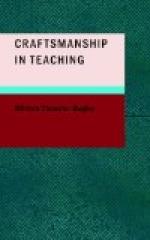The answer staggered me for a moment. Like ninety-nine per cent of the adult population of this globe, the seriousness of the child had never appealed to me. In spite of the theoretical basis of my training, that single, dominant element of child life had escaped me. I had gained my notion of the child from books, and, I also fear, from the Sunday supplements. To me, deep down in my heart, the child was an animated joke. I was immersed in unscientific preconceptions. But the master craftsman had gained his conception of child life from intimate, empirical acquaintance with the genus boy. He had gleaned from his experience that fundamental truth: “The child is the most serious creature in the world.”
Sometime I hope that I may make some fitting acknowledgment of the debt of gratitude that I owe to that man. The opportunities that I had to talk with him were all too few, but I did make a memorable visit to his school, and studied at first hand the great work that he was doing for the pupils of the Columbia district. He died the next year, and I shall never forget the words that stood beneath his picture that night in one of the daily papers: “Charles Howard: Architect of Character.”
II
The essence of the scientific spirit is to view experience without prejudice, and that was the lesson that I learned from the school system of St. Louis.
The difference between the ideal child and the real child,—the difference between what fancy pictures a schoolroom to be and what actual first-hand acquaintance shows that it is, the difference between a preconceived notion and an actual stubborn fact of experience,—these were among the lessons that I learned in these schools. But, at the same time, there was no crass materialism accompanying this teaching. There was no loss of the broader point of view. A fact is a fact, and we cannot get around it,—and this is what scientific method has insisted upon from its inception. But always beyond the fact is its significance, its meaning. That the St. Louis schools have for the last fifty years stood for the larger view; that they have never, so far as I know, exploited the new and the bizarre simply because it was new and strange,—this is due, I believe, to the insight and inspiration of the man[13] who first fashioned the framework of this system, and breathed into it as a system the vitalizing element of idealism. Personally, I have not always been in sympathy with the teachings of the Hegelian philosophy,—I have not always understood them,—but no man could witness the silent, steady, unchecked growth of the St. Louis schools without being firmly and indelibly impressed with dynamic value of a richly conceived and rigidly wrought system of fundamental principles. The cause of education has suffered much from the failure of educators to break loose from the shackles of the past. But it has, in some places, suffered still more from the




